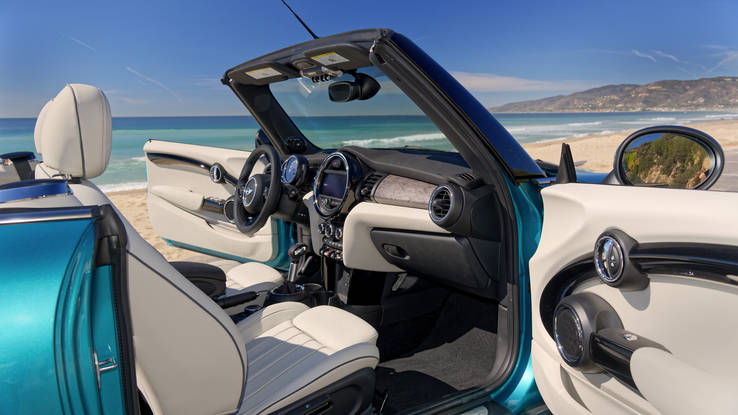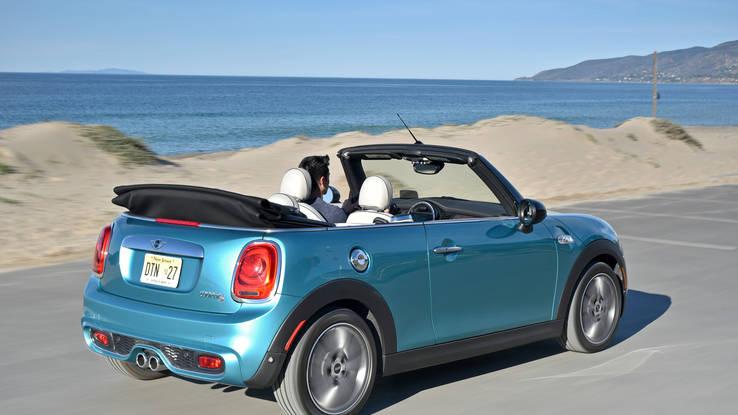Mini makes a mass-market sun tanner
The fourth-generation of Mini’s new convertible is larger and heavier but manages to be slightly more fun to drive, thanks to two more powerful powerplants. All Minis are fun to drive, of course — at least the Coopers are, and this is a Cooper. Those Clubman, Paceman and Spaceman Spiff editions stray a little farther from the original ethos of small, fun and agile.
The 2016 topless Minis offer either a 134-hp, 162-lb-ft turbocharged, direct-injected 1.5-liter three-banger that Mini lists for under $ 27K or a 189-hp, 207-lb-ft turbo four that costs just over $ 30,000. Both are mated to six-speed manual or six-speed automatic transmission driving the front wheels.
The previous Mini Convertible had only 121 hp from a 1.6-liter four and weighed roughly 2,800 pounds. The new Mini Convertible is more powerful even in its base, three-cylinder spec but weighs about 200 or so more pounds.
Styling is only slightly different. Mini lined up all four generations of its convertible and the last three are pretty similar. The roof is new, raising or lowering at speeds up to 18 mph and in only 18 seconds, with a new sort of half-open reverse-landaulette targa position that acts like a semi-sunroof. Other cutesey features include the Rain Warner app that tells you when rain’s a-comin’ so you can get the top up quickly, and the Always Open Timer that records total top-down time.

Open up world, it’s the new Mini Convertible
What’s it like to drive?
We weren’t offered time in a three-cylinder nor in the coming 228-hp John Cooper Works convertible. But we did get to drive both the manual and automatic versions of the Cooper S with the 2.0-liter turbo four.
We got in the automatic first. In slow LA traffic it felt really good, with solid low-end torque at throttle tip-in and what felt like a pretty stiff body. Mini reinforces the door sills, roll hoops, windshield frame and adds a plate under the engine to aid stiffness, and in stop-and-go city traffic it’s tight, with no cowl shake and electric power rack-and-pinion steering that feels well-connected to the road. Mini lists 0-60 at 6.7 seconds with the automatic and 6.8 in manual mode. Pushed a little harder on the freeway we felt cowl shake and a little shimmy in the body. Pushing it even harder than that on a twisty mountain road we felt the unmistakable plod of understeer, the bane of front-engines and front-wheel drive.
We drove the manual transmission Cooper S next. The big ball shifter worked just fine and we had no complaints about finding gears. After taking a detour out in The Valley that put us a little bit off route, we wound up on Decker Canyon Road, which may have been a better road than the one on the route list. Here, we pushed it harder still and the car felt pretty good going through the corners. The body twist is omnipresent and the harder we pushed, the more it understeered, so this is not a pure sports car or even a sports coupe, but it is fun to fling.

Pricing starts at just under $ 27,000. It’ll be in showrooms starting in March.
Do I want it?
Purist sporty car drivers will want the John Cooper Works Hardtop three-door. That thing is a blast. But there is a market for less-sporty convertibles and Mini has that covered with the Cooper S. The base model may even be reasonably priced at just $ 26,800, which includes destination. You can go cheaper with a Fiat 500 cabriolet, VW Dune droptop or even a Miata. And if you want to spend more money, well, the sky’s the limit. But Mini is doing better than it ever thought it would, selling 170,000 cars last year and far exceeding its original modest goal of 100,000, so it’s pretty well in touch with its U.S. buyers.


























